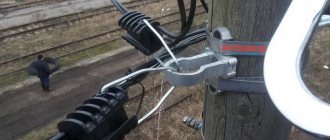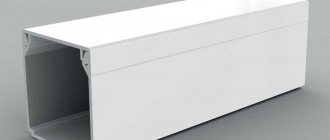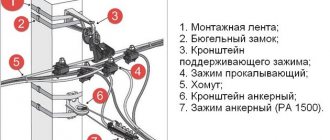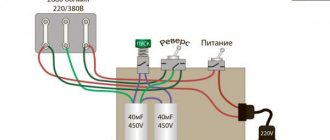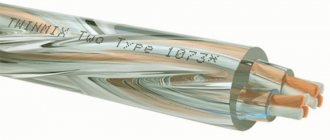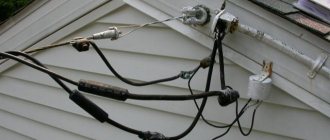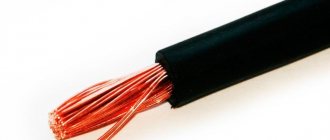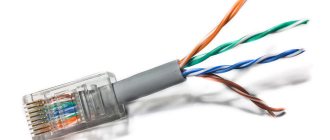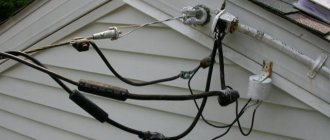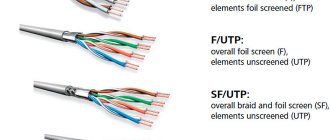Advantages and vulnerabilities of underground electrification
Supplying electricity underground
Introducing an electrical cable into a house underground instead of overhead lines has a number of advantages:
- does not spoil the architecture and design of the site;
- does not experience atmospheric influences;
- high fire safety.
In addition, eyeliner made in this way is protected from theft and vandalism. This is especially important if the building remains unattended for a long time.
Underground installation of electrical cables has some disadvantages:
- may be subject to mechanical stress during the process of swelling and subsidence of the soil;
- the influence of groundwater, soil freezing, pressure from the roots of large trees;
- Insects and rodents can damage the wiring;
- it is susceptible to aging and corrosion.
The durability of electrical wiring depends on the composition of the soil and its saturation with water, thermal fluctuations and vibration processes.
Tools and material required for the work
To carry out work on installing country electrical wiring, it is recommended to prepare the following tools in advance:
- CL cutting scissors;
- pliers;
- screwdrivers;
- screwdriver;
- grinder with diamond discs;
- hammer;
- mounting chisel;
- putty knife;
- roulette;
- knife.
Tools for laying electrical wiring
It is best to purchase material after drawing up a full-fledged project of the planned electrical network. The following items will be required:
- circuit breakers;
- electric meter;
- wires;
- sockets;
- switches;
- distribution boxes;
- socket boxes;
- connection terminals;
- fastening hardware.
Obtaining permission for underground input
An example of a project for introducing a cable into a house.
First, you need to complete the project. It should be developed by a specialist. Technical documentation, plans and drawings must comply with all rules and regulations. The designer determines the brand of cable and calculates the cross-section of the conductors.
To receive a project, a number of technical conditions must be met. To connect a house to a common power line, you will need appropriate permission. For example, an agreement for excavation work is drawn up by the service responsible for facilities and communications.
Then the land plot is traced. If there are any communications in the immediate vicinity of the cable being laid, it is necessary to invite their representative to coordinate the position of the trench and control the work being carried out.
Connection rules
To introduce electricity into a house from a pole, the new rules for connecting which you need to know in order to comply with the law, you need to have the appropriate skills.
The standard power of the connected network for entering a house on private plots is 4-6 kW, but if the owner has permission to build an individual dwelling, then he has the right to connect to a 15 kW network. This is necessary for the convenience of using high-power electrical appliances.
The supply must be carried out according to a design that is made taking into account the technical conditions prescribed individually for the site. Therefore, to connect the electrical network with new power, you need to submit an application to the energy supply company and indicate the required power (15 kW) and voltage (230/400 V). These parameters can be obtained by calculating the total consumption of all electrical appliances.
In the new technical specifications, the supplier company must indicate the permitted power, the size of the cable cross-section, their brand and type, as well as the requirements for protection and connection of the power grid to the house.
Connection to the home Source domelectrik.ru
Independent connection without approval of the project and permission from the energy supplier will entail a fine, but choosing the type of connection and participating in the discussion of the selected materials is recommended for those who understand at least something about this. Laying aluminum cables is prohibited on structures that are susceptible to fire. Therefore, it is necessary to replace it with copper analogues.
The distance from the balcony is required to be from 1 m for insulated and from 1.5 m for bare cables, and from a blank wall - from 20 cm for protected and 1 m for uncoated wires. Also, uninsulated overhead power lines are prohibited from running over buildings for safety reasons.
It is important! Any actions with power lines must be carried out only when the required section is completely disconnected, as well as with the application of portable grounding.
Schematic determination of distance Source www.allremont59.ru
Cable product compliance
Cable VBBShv 5x6
To supply electricity to the house, use products designed for installation in the ground. Since the electric cable will be under pressure from the mass of the soil, products in a special braid and armor are used. These are brands such as VB bShV and VB bShVng. The first letter in the marking indicates the presence of copper conductors. The armor is made with corrugated steel tape. It is wound in the form of a spiral along the inner layer of insulation.
The products are resistant to mechanical damage. Installation can be done without piping. However, to avoid damage during operation, it is recommended to use a pipe. If the ground has increased chemical activity - salt marshes, swamps, slag, construction waste - a cable with lead armor or an aluminum sheath is used.
Considering the complexity of installation work, it is better to immediately choose a high-quality cable, even if it costs more.
Coupling operating principle
The use of the coupling is permissible not only outside, but also inside objects, at any percentage of humidity. Such products can operate in a temperature range from -50 to 50 degrees.
The design of the couplings includes heat-shrinkable gloves, where on the inside there is a hot-melt adhesive layer, which is used to insulate the system cuffs and wire cores.
Installation process
Important! To better smooth the outer surface, a special light-colored mastic is used. As the coupling and gloves are seated, it becomes soft and excess air is removed from the cable.
To put the coupling into action, it is necessary to heat it with a special device, as a result of which the product layer expands. Below we describe how to choose the right connecting product for its purpose.
Entry using unarmored cable and HDPE pipe
Electrical network in a corrugated underground
If you need to supply electricity underground at your dacha, you can use a regular wire in a PVC sheath. For installation in the ground, it is better to choose sealed and fairly durable brands of cable products - NYM, VVG or SIP. They can be used, for example, to provide lighting in a country cellar. However, products under active external influence quickly fail.
To extend the service life, pipes made of low-density polyethylene (HDPE) are used as protection. They reliably protect against stray currents, mechanical damage and the influence of aggressive soil. Corrugated products can be used for this purpose. They have increased elasticity and strength, easily restore their linear dimensions, and are easy to install. Can be reused for frequent repairs. Some models are equipped with a probe, which makes it easier to pull the cable inside the corrugation.
Marking of low pressure polyethylene pipes
All HDPE pipes must be marked in accordance with the standards. Marking not only allows you to classify different types of pipes, but also makes it possible to control the quality of products - the applied markings are a guarantee of the suitability of the material for use.
Each pipe has symbols that display the trademark or full name of the manufacturing company. Labeling can be carried out according to national or international standards. The next element is the material of manufacture. For example, a pipe made of PE 80 is displayed as MRS 8. The pipe must also have a designation of the minimum wall thickness, outer diameter and nominal pressure (bar).
A separate paragraph may indicate the suitability of the pipe for constructing a gas pipeline network or transporting drinking water. The last marking point is the batch number and date of manufacture of the pipe.
HDPE pipes are divided into six classes, with the following designations:
- Heavy - T;
- Medium-heavy - ST;
- Medium-lightweight – OS;
- Average – C;
- Medium light - SL;
- Lungs – L.
Cable management protection
Signal tape
The standard trench depth is 90 cm, the thickness of the sand cushion is up to 20 cm. The cable is laid without tension, in a wave-like manner, always below the freezing point of the soil. Next, it is covered with a 30 cm layer of sand and earth, after laying warning tape.
If the soil is subject to shifts, is not dense enough, or is saturated with groundwater, additional protection is installed. Make a tray from concrete blocks or moisture-resistant bricks. The cable is laid in a tray and covered with a concrete slab on top. A reinforced concrete monolithic channel is made on creeping soil and covered with reinforced slabs.
Preparing the wiring diagram
To draw up a power distribution diagram at your dacha, you can use two options:
- classic - using a regular pencil and paper;
- modern - using specialized computer programs.
When performing work, it is not necessary to comply with established norms and rules. It is enough to accurately display the installation locations of switches, sockets, lamps, equipment, junction boxes, as well as the location of cable lines. It is first recommended to draw a schematic plan of a country house.
Electrical wiring diagram in a country house
Cable output
Finished trench from the house to the site
At the exit from the ground before connecting to the pole, a 2-meter section of cable must be covered with a curved metal pipe. The bending radius is at least 20 times the diameter of the cable sheath.
When laying a cable in the ground at the dacha to the house, it should be introduced through the foundation; for this you need to provide a mortgage. This is a piece of pipe extending 10–15 centimeters from the foundation on both sides. Its cross-section should be 4 times larger than the wire being laid. It is easy to insert the cable into the room through it. For subsequent sealing, use foam or rags soaked in cement laitance.
In another method, the cable in a metal pipe is raised along the house. This is usually where the introductory cabinet hangs. The embed is made in the wall, adhering to the same parameters, and the wire is brought into the house. This method is used if the foundation is made of a monolithic slab and you do not want to disturb it.
You can lay electrical cables underground using the puncture method. This method is used if wiring needs to be laid under a section of road or garden path. The essence of the method is to create a channel by pressing a metal pipe with a tip into the ground. At the same time, the soil around the device is compacted.
Connecting wires in the ground
Two holes are made on both sides of the obstacle, one starting, the other receiving. On the pipe, using a grinder, cut teeth in the form of a crown. The diameter must correspond to the size of the wire, but not less than 20 mm.
It is better to do the work together. The end of the pipe with the crown is installed in the starting hole. The other end is hit with a sledgehammer with great force. After passing 50 cm of the path, the inside of the pipe is washed from soil with water under pressure.
If there is not enough length to the receiving pit, an additional section is welded. When the crown teeth appear on the other side, the process is complete. The protruding ends are cut off on both sides, and the cable is inserted into the middle part. In this case, the pipe remaining in the ground is protection.
Follow the PUE
The cable must be laid in accordance with the Electrical Installation Rules. The document describes the basic requirements for the characteristics of wires, trenches, their design and equipment. All important nuances of cable laying are described in detail depending on their parameters, application conditions and soil properties.
In addition to the PUE, there is a standard project A5-92 for laying cables up to 35,000 V, which contains additional requirements for laying lines. You should also follow the rules and regulations of SNIP.
Cautions
The underground cable for electricity in a private house should only be armored.
The metal pipe for wiring should not be solid, since when it is filled with groundwater, the ice formed in severe frost will damage the cable.
The wiring must be grounded. To do this, a separate insulated wire is soldered to the armor. The second end is connected to ground on the shield or neutral terminal. In the event of an emergency, the machine will turn off the power.
Choosing the right cable and complying with all requirements during its installation is the basis for long-term and safe operation of the electrical main.
Problems caused by the location of the summer cottage
Most holiday villages are located outside the city. At the same time, old power lines are usually used to power them. They are not designed to withstand large flows of electrical energy that arise due to the use of a variety of household appliances. This is accompanied by periodic interruptions in electrical networks, which can lead to failure of equipment installed at the dacha. To eliminate this problem, you will need to use highly sensitive circuit breakers and voltage stabilizers.
Voltage stabilizer for a private home
The condition of the wiring of a summer cottage is strongly influenced by the frequency of stay in it. This fact must be taken into account when choosing a wiring method, since without heating in winter, moisture will accumulate inside the room. Oxidation of the contact connections will gradually occur, which will lead to a short circuit, and as a result, the need for restoration work.
Important! Taking into account the fact that the dacha plot is private property, the owners must take care of the installation of the grounding loop and lightning rod themselves.
